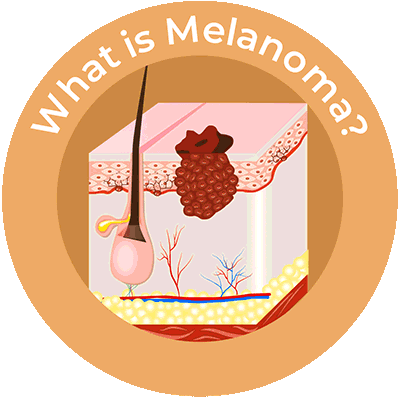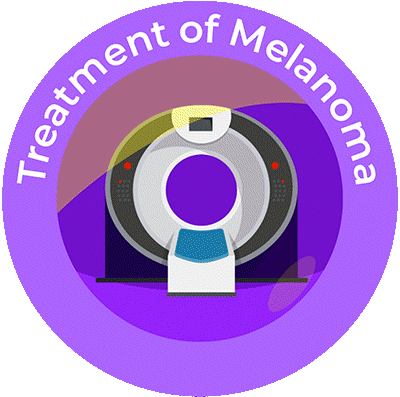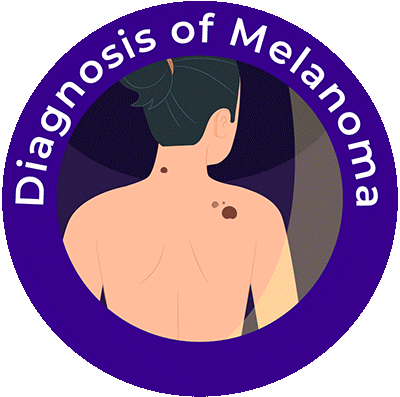This activity is provided by Med Learning Group.
This activity is supported by an independent medical education grant from Regeneron Pharmaceuticals, Inc.
Copyright © 2024 Med Learning Group. Built by Divigner. All Rights Reserved.
Diagnosis and Symptoms of Melanoma
Symptoms of melanoma
Early detection is key to preventing advanced melanoma. The ABCDE guidelines can help you identify an unusual mole.

General symptoms of advanced melanoma can include one or more of the following:2
- Hard or swollen lymph nodes
- Unexplained pain
- Unexplained weight loss
- Hard lump on the skin
- Extreme tiredness or feeling unwell
- Jaundice (yellowing of eyes and skin)
- Ascites (fluid build-up in the abdomen)
- Abdominal pain

Melanoma Diagnosis
Your doctor will arrive at your diagnosis following a physical exam and a biopsy.
A physical exam includes collecting your health history and examination of your skin to look for signs of melanoma This is followed by a biopsy, where a skin sample is procured for testing, if a suspicious skin lesion is detected. Types of biopsy include a punch biopsy where a circular blade is pressed into the skin surrounding the suspicious lesion or excisional biopsy where a scalpel is used to cut the entire lesion along with a small additional margin of healthy skin around it.4
Biopsy
Pathologists then collect a host of information about your skin sample including the thickness of the melanoma, the presence or absence of ulceration, the speed at which the cells are multiplying, presence of other immune cells within the sample, margin status (indicative of whether the cancer cells are seen at the deep/peripheral sides of the sample, and presence or absence of certain marker proteins. All of these parameters help the pathologist identify the type/sub-type of melanoma.5
Sentinel lymph node biopsy
Your doctor may also perform a sentinel lymph node biopsy (SLNB or SNB or lymphatic mapping), a surgical procedure done to identify the first lymph node that the cancer most likely spread to from the site of the primary melanoma, in order to analyze the melanoma cells, present there. Typically, a surgical oncologist will do this procedure. It involves the use of a dye and a harmless radioactive substance that is injected as close to the site of the first melanoma detected. The dye will flow through the lymphatic system and is followed to the sentinel lymph node. Cells collected are then sent to a pathologist who provides the final report.6 A negative report signals that the cancer has not spread to nearby lymph nodes while a positive report signals that the cancer has spread to nearby lymph nodes and possibly to other organs.
Other tests
You may be referred to a specialist(s) after an initial diagnosis and may require additional tests that can include an ultrasound, computed tomography (CT or CAT) scan, magnetic resonance imaging (MRI), and/pr positron emission tomography (PET) or PET-CT scan. All these will be done to further visualize your tumor(s) that may have spread to multiple organs.
References
- Mayo Clinic. Melanoma. Symptoms and causes. https://www.mayoclinic.org/diseases-conditions/melanoma/symptoms-causes/syc-20374884
- Cancer Research UK. Symptoms of advanced melanoma. https://www.cancerresearchuk.org/about-cancer/melanoma/advanced-melanoma/symptoms-advanced-melanoma
- National Cancer Institute. Melanoma treatment (PDQ®) patient version. https://www.cancer.gov/types/skin/patient/melanoma-treatment-pdq#_400
- Mayo Clinic, Melanoma. Diagnosis, and treatment. https://www.mayoclinic.org/diseases-conditions/melanoma/diagnosis-treatment/drc-20374888
- Net. Melanoma: Diagnosis. https://www.cancer.net/cancer-types/melanoma/diagnosis
- National Cancer Institute. Sentinel Lymph Node Biopsy. https://www.cancer.gov/about-cancer/diagnosis-staging/staging/sentinel-node-biopsy-fact-sheet
All URLs accessed on January 9, 2023.












